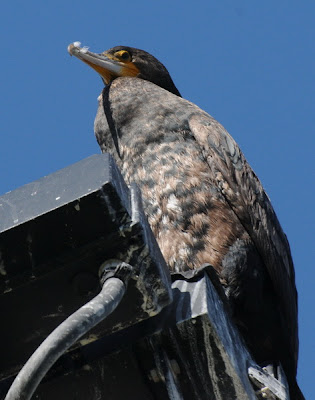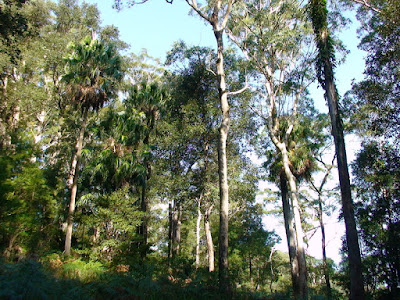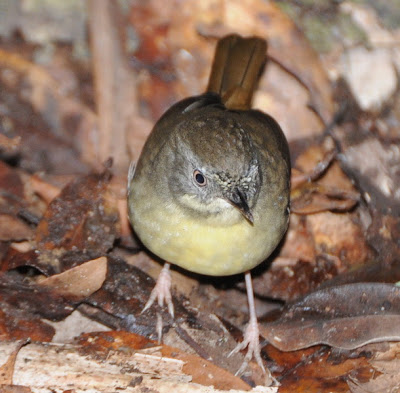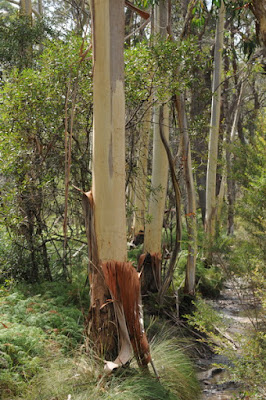On April 3, 2011, we followed up our excursion to the Blue Mountains with a trip to the sea. The coast from Sydney south to Wollongong boasts some spectacular views - here, from the Bald Hill Headland Reserve, a popular take-off point for hang gliders.
Eileen and Rita pose beside a plaque commemorating a new development since my day - the Sea Cliff Bridge, which isn't really a bridge at all but an elevated bit of highway skirting a coastal cliff.
The coastal highway, besides being scenic in the extreme, provides a number of good vantage points for watching coastal seabirds,
This is an Australian Pelican (Pelecanus conspicillatus), to my mind the handsomest of the world's pelicans.
The Great Cormorant (Phalacrocorax carbo) is one of the most widespread seabirds in the world, ranging from the eastern coast of North America across Europe and Asia to Australia and New Zealand.
Not a seabird (despite the Tasman Sea in the background) but a Willie-Wagtail - which is not a wagtail either, but a fantail (Rhipidura leucophrys). TThough it is certainly the best-known of its family, it is rather atypical for a fantail; most of the others are forest birds. Unlike the true wagtails (Motacilla), the Willie-Wagtail wags his tail not up and down, but from side to side.
Not far from the Willie-Wagtail, I found an immature Grey Butcherbird (Cracticus torquatus) sheltering from the sun in the middle of a bush.
On the way north from the Wollongong coast we entered a stretch of coastal heathland, a dense and nearly treeless growth of closely-packed shrubs dominated by a number of species of Banksia.
These are not fruits of a Banksia, but of one of the eucalypts or their relatives (I'm not sure which) - little woody cups, once topped (if this indeed a eucalypt) with the little caps that give Eucalyptus ("well-capped") its name.
I found four species of banksia growing together: Heath Banksia (Banksia ericifolia), with narrow leaves recalling those of the true heaths and heathers and bright orange floral spikes whose show of fall colour makes up, to some extent, for the absence of autumnal leaf show in the Australian woodlands...
Coast Banksia (Banksia integrifolia), with pale yellow flowers and coarse, toothed leaves....
Silver Banksia (Banksia marginata), named for the silvery sheen on the undersides of its leaves...
....and Old Man Banksia (Banksia serrata), with its grotesque and rather fearsome-looking fruiting spikes, each seeming to sport several mouths (these are the fruits themselves, or follicles, that have opened to release their seeds). The spikes (or cones, as they are usually called) were "ugly little, wicked little men" in the mind one of Australia's most famous childrens' writers, Cecilia May Gibbs (1877-1969).
Gibbs was the author of a series of tales about, of all things, a pair of animated eucalyptus fruits (the "gumnut babies"), rather revoltingly named Snugglepot and Cuddlepie. Add arms and legs to Old Man Banksia cones (as shown in this drawing from Gibbs' novel Snugglepot and Cuddlepie) and you have the Big Bad Banksia Men, Snugglepot and Cuddlepie's chief nemeses. Gibbs' stories are still in print, and have inspired both a ballet and a musical.
Banksias in flower literally drip nectar, a fact not lost on a number of honeyeater species that swarm into the heathland when the cones are in bloom. This is one of the larger species, the Little Wattlebird (Anthochaera chrysoptera).
Further north, almost on the outskirts of Sydney, is the famous Royal National Park, the world's second oldest (it was gazetted in 1879). Lady Carrington Drive is a well-known spot for temperate rainforest birds, so although it was already afternoon I couldn't resist the chance for a short stroll before we headed back to town.
There are some magnificent trees along Lady Carrington. This is one of several smooth-barked eucalypts in the area, but I'm not sure which one.
The undergrowth is carpeted with ferns; I believe this is Trim Shield Fern (Lastreopsis decomposita), a species that spreads by rhizomes and may form large colonies in the rainforest.
There are only two native palms in the Sydney region; this is a young Cabbage Tree Palm (Livistonia australis), a tree that can reach 30 metres in height when mature.
I believe that the white flowers on the right (but not the large leaves on the left) belong to one of the many species of tea-tree (Leptospermum), cousins to the manuka and kanuka of New Zealand.
I am particularly fond of fantails. The Grey Fantail (Rhipidura fuliginosa) is the common forest species in Australia, and is a much more typical representative of its genus than the open-country, largely terrestrial Willie-Wagtail. Like many (but not all) fantails, it is bold, active and inquisitive, and a pleasure to watch.
Fantails (again, most of them) fan and twitch their tails more or less constantly, often accompanying their fanning by spreading and flicking their wings. This behaviour, oddly, helps them find food. Here you can see this one apparently displaying to a tree trunk; it is actually trying to startle insects into revealing their hiding places on the bark, so they can be snapped up. This "flushing behaviour" has evolved a number of times in songbirds; the tropical American redstarts (Myioborus), for example, do the same sort of thing, as does the Pied Monarch (Arses kaupi) of northern Queensland.
For sheer charm, tough, it's hard to beat the fairy-wrens (Maluridae), even when the males are not sporting their brilliant breeding colours. These are Superb Fairy-Wrens (Malurus cyaneus), the only ones I saw on our trip - though this was once a bird that seemed to inhabit every garden in Sydney. As with many other small birds, they seem to have been driven out of town (see my earlier post for more on this problem).
Fairy-wrens have a remarkable mating system featuring group living, multiple pairings and intense competition among males (males have, proportionately, among the largest testes - reportedly reaching, together, 25% of their body weight in the breeding season - and highest levels of sperm production in either birds or mammals). If this interests you it is worth reading the account of the family in the Handbook of the Birds of the World, fortunately available online if you don't own the series.
Fairy-wrens have a remarkable mating system featuring group living, multiple pairings and intense competition among males (males have, proportionately, among the largest testes - reportedly reaching, together, 25% of their body weight in the breeding season - and highest levels of sperm production in either birds or mammals). If this interests you it is worth reading the account of the family in the Handbook of the Birds of the World, fortunately available online if you don't own the series.
Near the other end of the songbird size scale is one of Australia's most famous birds (and perhaps the most accomplished and impressive songster and vocal mimic in the bird world), the Superb Lyrebird (Menura novaehollandiae), and Lady Carrington Drive is a good place to see it. I startled this one from a patch of leaf litter - perhaps his display ground - and only had time to get off one quick shot before he fled into the bushes.
The lyrebird, however, had not been alone. Lyrebirds have relatively enormous feet and are inveterate leaf-scratchers, turning up not only food for themselves but a bonanza of insects for small birds that folow them around. One species is even called the Pilotbird (Pycnoptilus floccosus) because of its habit of following lyrebirds, much as pilotfishes follow sharks. This, however, is a White-browed Scrubwren (Sericornis frontalis), and it was not about to relinquish a prime, lyrebird-scratched foraging ground simply because I, a lowly birder, was nearby!















































































